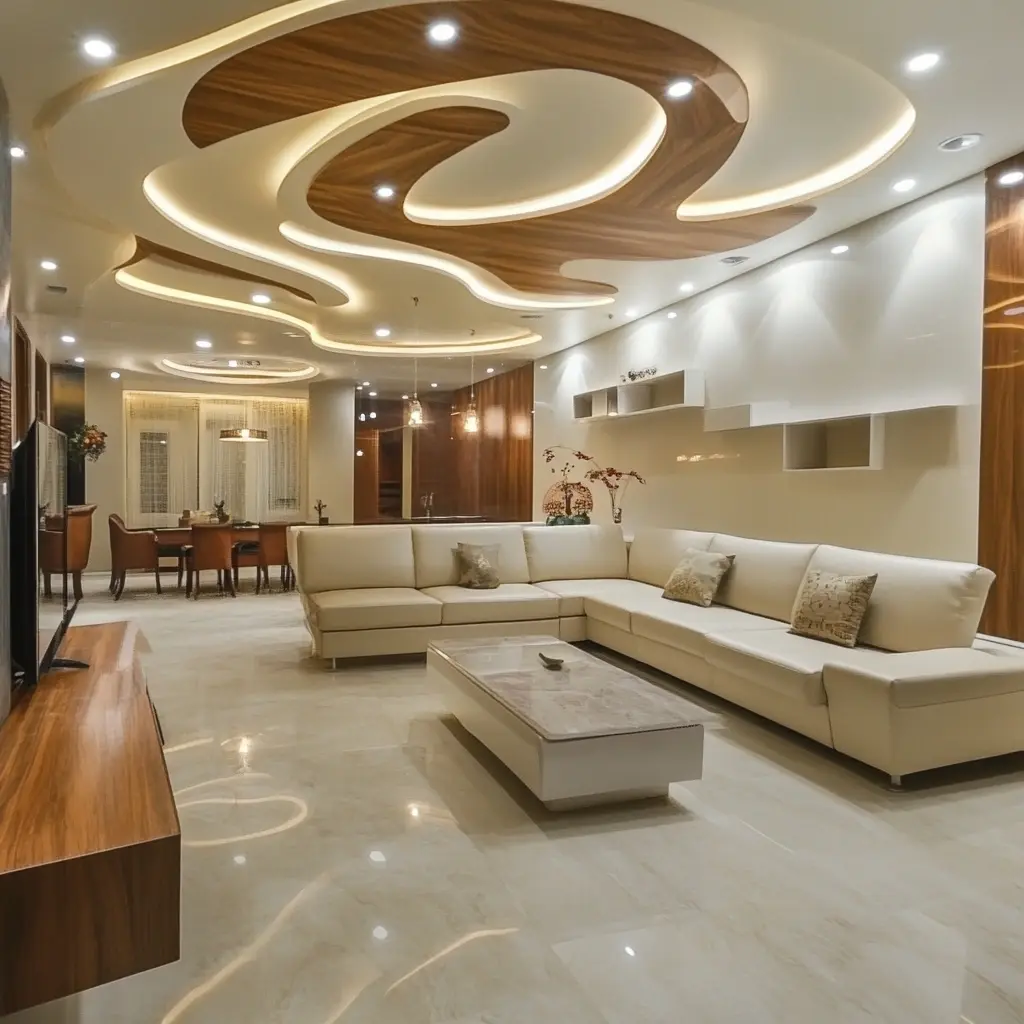Contact Us
Get in Touch

There are different types of false ceiling designs and materials to choose from based on use and location where they are fixed. Whether it is an easy simple false ceiling design or the best intricate false ceiling design pattern, we can help you bring your false ceiling design vision into reality.
With knowledge on the materials, you can make a more informed decision and select an apt ceiling based on look and function. When it comes to fall or down ceiling designs for halls and bedrooms, as a customer, it is recommended that you orient yourself to the different materials available in the market today:
Wooden ceiling design
Wooden false ceiling designs are a beautiful addition to the hall or the bedroom owing to their warm appearance.
Advantages:
Natural aesthetic appearance with premium look
Suitable for cold climatic conditions
Easy installation
Durable
Customizable as they can be finished based on colour or design preferences
Disadvantages:
Expensive installation and maintenance
Susceptible to termite infestation
POP false ceiling design
POP is a popular false ceiling material that is often confused with gypsum- however, they are distinct from one another. Plaster of Paris is gypsum heated to rid it of the water content and this powder coats chicken net material to form the base for false ceiling designs.
Advantages:
Budget-friendly
Durable
Good insulators of cold and heat
Low maintenance ceiling material
Customizable as they can be finished based on colour or design preferences
Disadvantages:
Has a tendency to crack over long periods of time
Can reduce the room’s available height
Absorbs moisture and susceptible to fungus
Gypsum false ceiling design
One of the most popular options for false ceiling materials, gypsum has several advantages. It is usually built onto an iron base to create a false ceiling design.
Advantages:
Durable
Lightweight material ideal for false ceilings
Good insulators of cold and heat
Fire-resistant
Easy to install
Easy to maintain
Customizable as they can be finished based on colour or design preferences
Disadvantages:
More expensive than POP false ceiling designs
Can reduce the room’s available height
Susceptible to fungus
PVC false ceiling design
Polyvinyl chloride (PVC) is a plastic false ceiling material often preferred due to its obvious advantages.
Advantages:
Budget-friendly
Easy installation process
Easy to maintain
Lightweight material
Waterproof and moisture resistant
Resistant to termite infestation
Customizable as they can be finished based on colour or design preferences
Disadvantages:
Has a plastic appearance with visible joints which may not be suitable for all spaces
Susceptible to damage from heat
Not an environment friendly material
Metal false ceiling design
Metal false ceiling designs are made using iron, aluminium or tin. They often offer an industrial look to a room and are preferred for commercial projects but are now seen in residential spaces too.
Advantages:
Durable
Low maintenance
Easy to install and remove
Waterproof and moisture resistant
Fire resistant
Resistant to termite infestation
Customizable as they can be finished based on preferences
Disadvantages:
Expensive
Needs coating to prevent corrosion
Fibre false ceiling design
Fibre false ceilings are preferred for commercial spaces and are not usually aesthetically suited for residential projects.
Advantages:
Economical cost
Soundproof
Durable material
Insulation to heat
Disadvantages:
Not as aesthetic for residential projects as other false ceiling materials
Glass false ceiling design
For a unique appearance when it comes to residential false ceilings, a glass ceiling is recommended.
Advantages:
Aesthetic appearance making a space look bigger
Premium finish
Heat insulation
Customizable as they can be finished based on preferences
Disadvantages:
Brittle material
Difficult installation
Fabric false ceiling design
Not as practical as other false ceiling materials, fabric is used only for flair. They are a preferred choice for temporary ceilings.
Advantages:
Can be easily customised to suit preference
Ideal for a temporary ceiling solution
Easy installation
Disadvantages:
Difficult to maintain over long-term use
Not durable
Please note that it is important that the ceiling light and fan design are planned prior to the installation of the false ceiling design.
To know more Reach out to us at info@agnikone.com. With showrooms in Trivandrum, Kollam, Cherthala, Kochi, and Thrissur, we proudly serve customers across Kerala. Contact us to start your transformation today.
Get in Touch